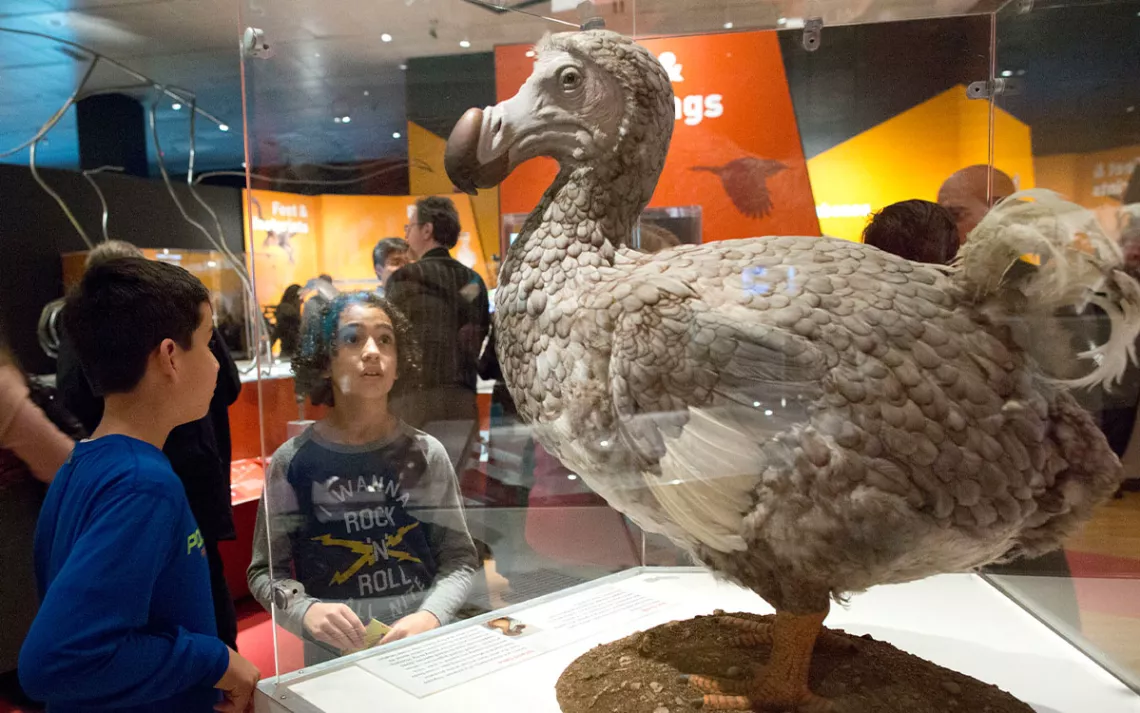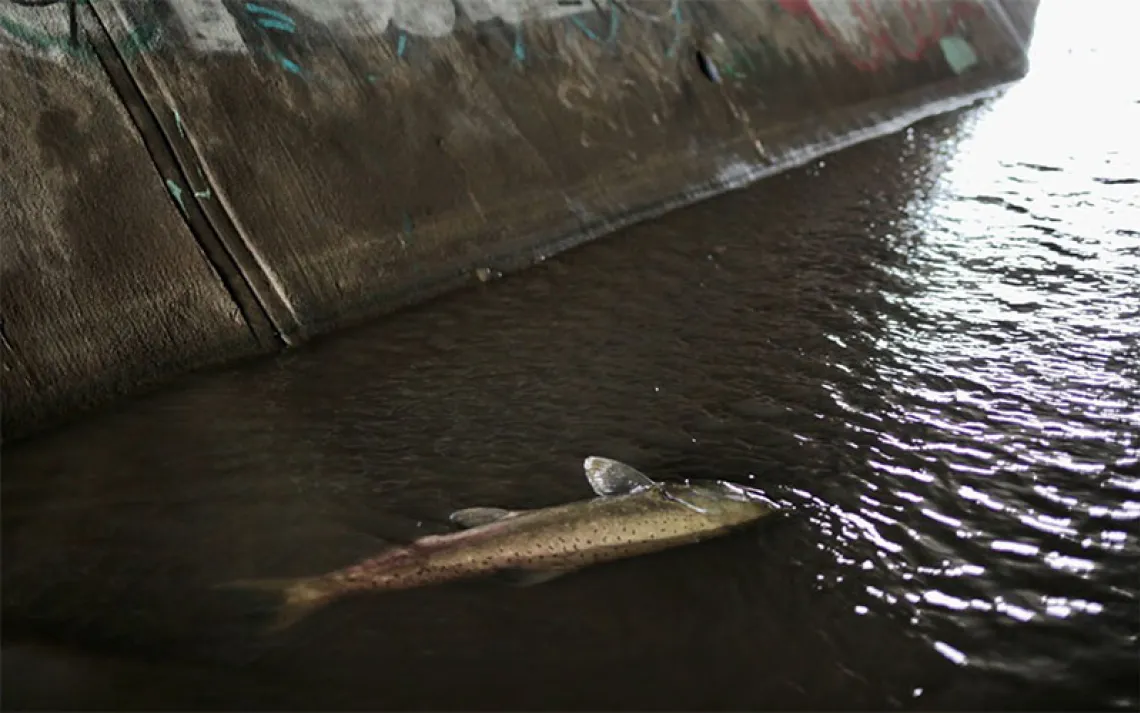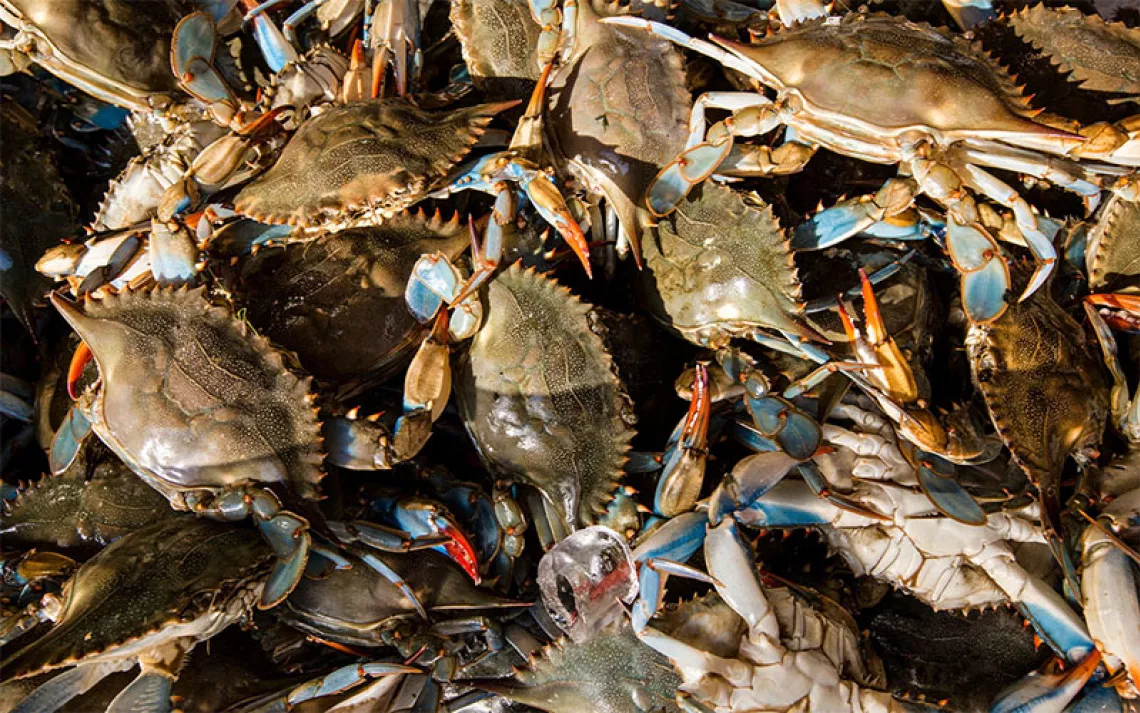This Texas Company Wants to Bring Species Back From the Dead
Proponents of the de-extinction movement press on with little research and lots of fanfare

Fourth graders from PS 87 inspect a model of a dodo bird during a press preview of “Dinosaurs Among Us” at the American Museum of Natural History in New York City. | Photo by Mary Altaffer/AP
Vikash Tatayah, the conservation director of the Mauritian Wildlife Foundation, was stunned when he learned that scientists at a Texas-based biotech company were hoping to reintroduce a now-extinct species of bird that once roamed the island of Mauritius. “I didn’t even know that the company existed,” Tatayah said. Leaders at Colossal Biosciences hope to bring the dodo back from the dead by genetically engineering animals into existence after centuries of extinction.
To do this, researchers would have to identify the genes that made the dodo unique and insert them into a close relative, the Nicobar pigeon, so that the resulting offspring resembles its extinct cousin. The result wouldn’t quite be the extinct animal, but it wouldn’t be the still-living species either; it’d be something entirely new. That makes this process, called de-extinction, distinct from cloning.
The Mauritian Wildlife Foundation has since partnered with Colossal for one primary reason: money. The company, founded in 2021, is estimated to be worth around $1.5 billion and has attracted high-profile investors like Peter Thiel, Paris Hilton, and Chris Hemsworth, as well as the CIA’s venture capital firm In-Q-Tel. The dodo project was announced in January 2023, joining the thylacine (a.k.a. the Tasmanian tiger) and the woolly mammoth in Colossal’s de-extinction portfolio.
Colossal's supporters claim that genetically engineering animals to resemble extinct ones and releasing them into the wild will help “heal the world” and fight the ongoing extinction crisis. But the company has had several missteps along the way, including moving forward without consulting locals. And as the science demonstrates, evidence that de-extinction can deliver its promised benefits is far from clear.
Should Colossal succeed, it’s highly unlikely that releasing the pseudo-dodo would provide a significant environmental benefit to Mauritius. “The introduction of the dodo will not change the ecosystem,” Ben Lamm, Colossal’s co-founder and CEO said. Rather, de-extinction of the dodo will represent a symbolic victory.
Not only will the “return” of the dodo do nothing to heal Mauritius’s forested ecosystems, but that part actually has to come first. With funding from Colossal, the Mauritian Wildlife Foundation will restore dodo habitat and remove invasive species, like pigs and rats, both of which helped cause the dodo’s extinction. While Tatayah is excited about the partnership with Colossal, he would have preferred to focus on animals and plants that haven’t yet gone extinct. Ultimately, he said, Colossal is providing a pot of money for projects like the foundation’s pink pigeon conservation program, which otherwise wouldn’t attract attention from big donors.
“If it was a question of having these funds and being able to do either, I would definitely go on trying to save the existing diversity on Mauritius, which is declining,” Tatayah said. “There’s no two ways about it.”
Colossal’s top-down approach in Mauritius reminds Rebecca Shaw, chief scientist of the World Wildlife Fund, of the outdated conservation of 25 years ago. “You can’t get anything to stick in places around the globe, with respect to conservation outcomes, if people that live in those places aren’t part of the solution to begin with,” Shaw said. “Companies are tone-deaf in a lot of ways to those kinds of realities.”
On another island, more than 5,000 miles from Mauritius, lived another animal the Western world never got the chance to know. After the arrival of the dingo pushed the thylacine out of mainland Australia, the carnivorous marsupial survived on the nearby island of Tasmania until British colonizers decided that it looked a bit too much like a wolf. Fearing for the lives of their sheep, farmers and bounty hunters shot the thylacine into extinction. No one bothered to seriously study its ecology or behavior.
In 2022, Colossal announced plans to create a pseudo-thylacine by genetically engineering another carnivorous marsupial, the fat-tailed dunnart. The scale of this endeavor is staggering. “A thylacine is 2,000 times the size of a dunnart,” mammalogist Kristofer Helgen of the Australian Museum in Sydney wrote on Twitter after the announcement, and the two are distant relatives separated by about 40 million years of evolution. “Can you turn a bear into a dog? No.” But if a thylacine-like animal were to return to Tasmania, it would likely lead to some positive effects—at least according to our best speculation.
If Colossal succeeds in creating a pseudo-thylacine, and if the animal’s behavior is similar to that of a real thylacine, Douglass Rovinsky, an ecologist who studies the creatures, strongly surmises that there would be positive effects. From an ecological perspective, they might serve as apex predators, slightly edging out the smaller Tasmanian devils that currently occupy the top spot. Back in place, pseudo-thylacines could help reduce the damaging feral cat population and leave carcasses in wild areas that could draw scavenging devils away from roads (where they often become roadkill). “The removal of top-level predators always destabilizes an ecosystem,” Rovinsky said.
Colossal claims that it could have a pseudo-thylacine pup born as early as 2028, but successfully reintroducing a predator into an ecosystem is a long process. For example, people first started talking about reintroducing wolves to Yellowstone National Park in the 1940s, with the canines finally making a comeback about 50 years later. “This is not done willy-nilly,” said Joanna Lambert, a wildlife biologist at the University of Colorado Boulder who worked on recent wolf introductions in her state. “Especially when it comes to apex predators, it’s a serious business.” Pulling off a reintroduction requires extensive analysis of habitat quality and of what impact the homecoming animal will have, as well as in-depth engagement with local communities.
Colossal’s progress on these fronts so far seems to be lacking. “I’ve seen no evidence of anyone in Tasmania thinking this is a grand idea,” said Philip Cocker, chair of the conservation organization Environment Tasmania. “And we certainly haven’t been spoken to about it.” After Cocker and I talked, Colossal announced the formation of a Tasmania Thylacine Advisory Committee. Asked what he thought of it, Cocker said, “It reads more like a tourist venture is being pursued.” No environmental groups, no biologists, no government wildlife officials, and no historians. “I see a distinct lack of biodiversity skill management amongst the participants.”
De-extinction’s flagship species, the woolly mammoth, arguably has the most evidence supporting the value of its revival. Since 1996, a Russian team led by father-son duo Sergey and Nikita Zimov has been running Pleistocene Park, a fenced-in enclosure of Siberian wilderness where large herbivores—like musk oxen, bison, and reindeer—have been introduced. Colossal researchers claim, based on evidence from Pleistocene Park, that its pseudo-mammoth will do what large herbivores do: pack down the soil and help keep it frozen, preventing greenhouse gases trapped in the permafrost from escaping.
Proponents of mammoth de-extinction have extolled its purported ability to fight climate change since at least 2013. However, a 2016 paper decried the lack of “any quantitative data concerning the impacts of megafauna reintroductions.” A 2020 study found that introduced herbivores in Pleistocene Park lowered soil temperatures, but only during winter and spring. Two other studies from 2022 showed some contradictory results: One found that there has been less thawing of frozen soil in parts of Pleistocene Park following herbivore introductions, while the other found warmer soil temperatures. Both studies cautioned that they were unable to determine whether their findings were actually caused by the introduced herbivores or not.
“This research is very much in early stages with a lot more to do,” said Jacquelyn Gill, a paleoecologist at the University of Maine. “There’s some discussion about how well some of these rewilding scenarios really mimic natural processes.” To the question of what introducing large herbivores does to the environment, Gill said, “The jury is definitely still out.”
To help solve larger issues such as the biodiversity crisis, Colossal's team is working on what it calls a “de-extinction tool kit,” consisting of techniques like assisted reproduction and genetic engineering. Some experts, however, are skeptical about how much utility pursuing de-extinction will provide for living animals. “Threats to most populations are not solved by one gene that you’re bringing in,” said Sarah Fitzpatrick, a conservation geneticist at Michigan State University. Small populations often suffer from a lack of genetic diversity across their entire genomes, a problem that is better fixed by restoring lost habitat and connecting disparate populations so that they can intermingle. “I just don't think that gene editing is the answer there,” Fitzpatrick said.
The tool most often used for genetic engineering, CRISPR, is well established in many organisms; a scientist looking to genetically engineer a disease-resistance gene into an endangered population, for example, could do so without needing to first work with DNA from an extinct species. Assisted reproduction, including for the northern white rhino, has also progressed by working with the rhinos themselves, not with their extinct relatives.
Overall, despite more than a decade of hype, there is little evidence supporting de-extinction as a conservation strategy. This imbalance between media attention and serious science has led to few in the conservation community taking de-extinction seriously. “At this stage, it’s looked more like a scientific novelty to us,” said Cocker of Environment Tasmania. “As much as I would love to see those animals back on the landscape, I think it’s a bit of a sideshow,” said Noah Greenwald, endangered species director at the Center for Biological Diversity. “What we really need to focus on is stopping extinction of species that still survive.”
Shaw, of the World Wildlife Fund, was blunt in her assessment of Colossal. “It’s a tech company,” she said. “They make outrageous claims all the time.”
This article has been updated to include the correct invasive species on the island of Mauritius.
 The Magazine of The Sierra Club
The Magazine of The Sierra Club



